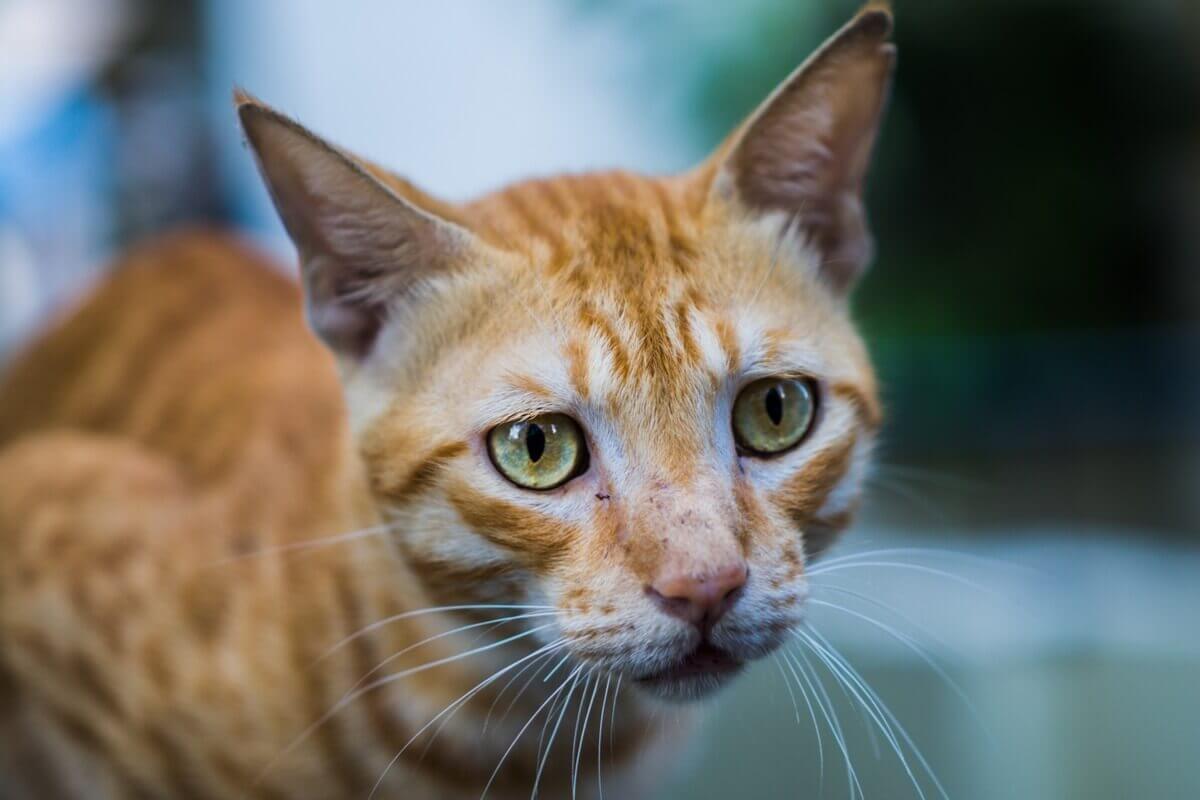10 Signs Your Cat Could Have Cancer


Written and verified by the biologist Samuel Sanchez
1 in 5 cats will develop cancer in their lifetime. The probability that something goes wrong in the animal’s body increases with the passing of time, so a possible neoplasm should never be ruled out when you notice a very drastic behavioral change in a senior feline. To help you discern between normality and illness, here are 10 signs that your cat could have cancer.
Nobody likes to talk about malignant tumors, because unfortunately, this group of diseases is very prevalent in human society and in other animals as well. In any case, diagnosing a condition of this type in time can mean the difference between life and death for the pet. Even if it’s an unpleasant subject, you need to inform yourself about it.
What are the signs that your cat could have cancer?
The term “cancer” refers to a heterogeneous group of diseases, but they all have something in common. In these conditions, there’s an excessive proliferation of a specific cell line, which results in the formation of an abnormal mass called a tumor. When the tumor’s malignant, the cells that compose it are capable of migrating to other tissues in an event known as metastasis.
The symptoms of a localized tumor are usually specific, while metastasis manifests itself with an organic and generalized symptomology. Now that we’ve made these things clear, we’re ready to explore the 12 signs that indicate that your cat could have cancer. Keep reading.
1. Appearance of lumps under the skin
The appearance of a lump under the animal’s skin isn’t usually a sign of cancer, but you must be very careful with lymphomas. These account for 30% of the total cancers of the species and can consist of various types, but they’re always characterized by a common feature: The pathological overproduction of lymphocytes.
Some lymphomas cause gastrointestinal symptoms, but others cause swollen lymph nodes. In the latter cases, you may notice inflammations under your cat’s skin that don’t correspond to wounds or bruises.
Fibrosarcoma is another type of cancer in cats that involves lumps under the skin.

2. Lumps on the skin
Melanomas only represent 0.5% of total cancers in cats, but great care must be taken if a black and obvious lump is observed on the animal’s skin, no matter where it appears. This clinical sign always warrants a visit to the vet.
3. Lumps in the breasts
90% of mammary tumors in felines are cancerous. Therefore, if you find a lump inside or next to your cat’s nipple when you massage her belly, you should suspect the worst. This cancer is very aggressive and spreads easily to other tissues, so it must be removed as soon as possible and chemotherapy applied.
If the cat is neutered, the chances of developing this cancer drop drastically.
4. Changes in appetite
A change in appetite is one of the signs of cancer in cats, but it can also be caused by many other things. For example, your pet may be stressed, have a food intolerance, or have a gastrointestinal problem. These changes are common, but shouldn’t be allowed to continue for more than 24 hours without seeking veterinary care.
5. Chronic weight loss
Chronic weight loss is a sign of disease in the cat in all cases. It’s doesn’t always occur due to cancer, but when it does respond to this clinical picture, it usually indicates that the main tumor has spread to other parts of the body. Be that as it may, it’s always a bad sign.
6. Persistent cough
In cats, most of the time, coughing manifests itself as an inflammation of the lower respiratory tract. However, cancers such as mediastinal lymphoma cause swellings that press on the chest, resulting in coughing and chronic shortness of breath.
7. Bad smell from the mouth
A bad smell from the mouth can be one of the signs that a cat has cancer, especially if swelling occurs in the oral cavity. In these cases, the animal will also have difficulty eating, bleed from the corner of its lips, and may even lose its teeth.
Oral squamous cell carcinoma is quite common in cats.
8. Bleeding
Superficial bleeding is usually a sign of an injury or accident, but the situation changes a lot when the bleeding is internal. If your cat vomits, urinates, or defecates bloody fluids, it’s time to go to the emergency room. You most likely have a very serious illness.
9. Wounds or rashes that don’t heal
Skin ulcers are one of the signs that a cat has cancer, especially melanoma or breast cancer. In general, a wound that doesn’t heal or that’s continuously infected indicates that the animal’s immune system isn’t working well or that there’s a tumor mass pressing on certain structures of the skin.
10. Elusive attitude
This symptom is subjective, as only the owner knows how sociable the animal is on a normal basis. Cats have a strong survival instinct, so faced with weakness, they often choose to take refuge and not let anyone see them. For this reason, the disease is associated with the loss of socialization.

There are many signs that a cat has cancer, but these can easily be mistaken for normal behaviors or attributed to other conditions. Faced with any of the aforementioned symptoms, you should take your feline to the vet to rule out any severe clinical picture. Most likely, it’s not a malignant tumor, but it’s always better to be safe than sorry.
All cited sources were thoroughly reviewed by our team to ensure their quality, reliability, currency, and validity. The bibliography of this article was considered reliable and of academic or scientific accuracy.
- Morrison, W. B. (2002). Cancer in dogs and cats: medical and surgical management. Teton NewMedia.
- Cannon, C. M. (2015). Cats, cancer and comparative oncology. Veterinary sciences, 2(3), 111-126.
- Dorn, C. R., Taylor, D. O. N., Schneider, R., Hibbard, H. H., & Klauber, M. R. (1968). Survey of animal neoplasms in Alameda and Contra Costa Counties, California. II. Cancer morbidity in dogs and cats from Alameda County. Journal of the National Cancer Institute, 40(2), 307-318.
This text is provided for informational purposes only and does not replace consultation with a professional. If in doubt, consult your specialist.